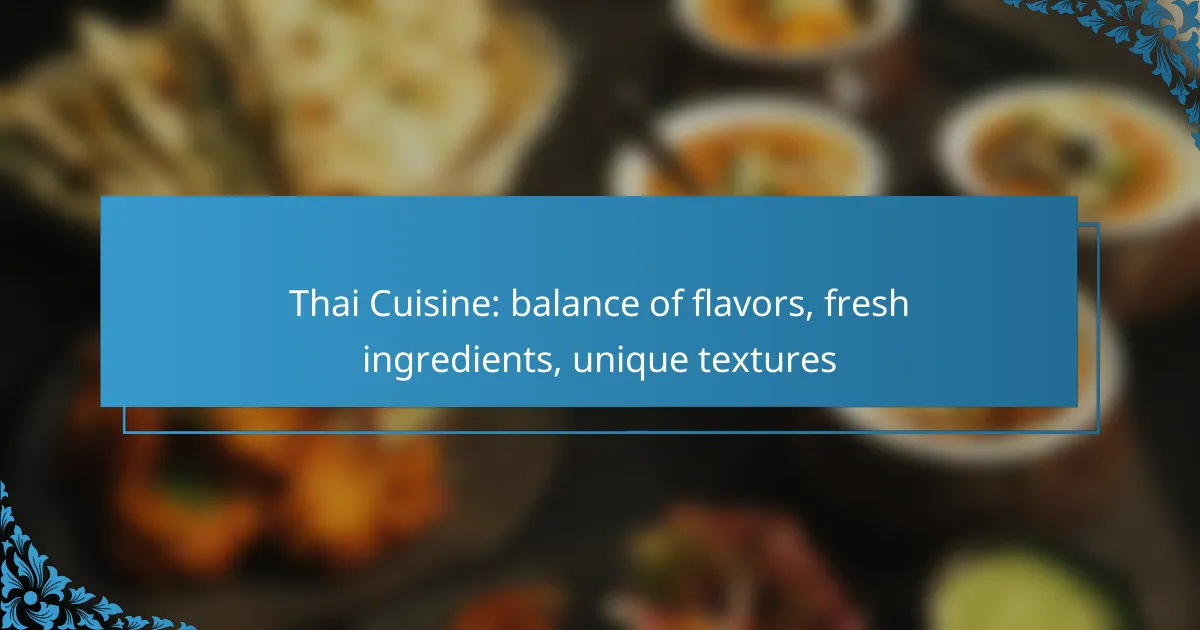Thai cuisine is renowned for its exquisite balance of flavors, seamlessly blending sweet, sour, salty, and spicy elements to create a complex and satisfying taste experience. Fresh ingredients play a crucial role, with vibrant herbs, spices, and vegetables enhancing each dish’s unique textures and aromas. This culinary tradition invites diners to explore a diverse array of dishes that reflect the rich cultural heritage of Thailand.

What are the best Thai dishes to try in Los Angeles?
Los Angeles offers a vibrant Thai food scene with a variety of dishes that showcase the balance of flavors, fresh ingredients, and unique textures characteristic of Thai cuisine. Some of the must-try dishes include Pad Thai, Green Curry, Tom Yum Soup, Massaman Curry, and Som Tum.
Pad Thai
Pad Thai is a quintessential Thai dish that features stir-fried rice noodles, typically combined with shrimp, chicken, or tofu, and tossed with eggs, bean sprouts, and peanuts. The dish is known for its balance of sweet, sour, and salty flavors, often enhanced with lime and chili.
When ordering Pad Thai in Los Angeles, look for restaurants that use fresh ingredients and prepare the noodles to a perfect al dente texture. A good Pad Thai should have a slightly smoky flavor from the wok, making it a satisfying meal.
Green Curry
Green Curry, or Gaeng Keow Wan, is a spicy and aromatic dish made with green curry paste, coconut milk, and a variety of vegetables and proteins, such as chicken or beef. The vibrant green color comes from fresh green chilies and herbs, providing a rich and creamy texture.
In Los Angeles, many Thai restaurants offer customizable spice levels for Green Curry, allowing you to adjust the heat to your preference. Pair it with jasmine rice to balance the flavors and enjoy the dish’s unique complexity.
Tom Yum Soup
Tom Yum Soup is a hot and sour Thai soup that typically includes shrimp, mushrooms, and fresh herbs like lemongrass and kaffir lime leaves. The broth is both fragrant and flavorful, making it a popular choice for those seeking a comforting yet invigorating dish.
When trying Tom Yum Soup in LA, pay attention to the balance of sourness and spiciness. A well-made soup should have a clear broth with a robust flavor profile, often served with a side of rice to complement the dish.
Massaman Curry
Massaman Curry is a rich and mildly spiced curry that reflects influences from Indian cuisine, featuring tender meat, potatoes, and peanuts in a creamy coconut milk base. The flavor is a harmonious blend of sweet, savory, and nutty elements.
In Los Angeles, Massaman Curry is often served with rice and is a great option for those who prefer a less spicy dish. Look for restaurants that use high-quality ingredients to ensure the curry’s depth of flavor shines through.
Som Tum
Som Tum, or green papaya salad, is a refreshing and zesty dish made from shredded unripe papaya, tomatoes, green beans, and a tangy dressing of lime juice, fish sauce, and palm sugar. It’s often topped with peanuts and sometimes includes dried shrimp or crab.
This salad is a perfect complement to heavier dishes and is popular for its crunchy texture and vibrant flavors. In LA, you can find variations of Som Tum that cater to different spice levels, making it a versatile choice for any palate.

How does Thai cuisine balance flavors?
Thai cuisine achieves a remarkable balance of flavors by combining sweet, sour, salty, and spicy elements in each dish. This harmony creates a complex taste experience that is both refreshing and satisfying, often utilizing fresh ingredients to enhance the overall profile.
Sweet, sour, salty, and spicy harmony
The balance of sweet, sour, salty, and spicy flavors is fundamental to Thai cooking. For instance, dishes like Pad Thai incorporate sugar for sweetness, lime for acidity, fish sauce for saltiness, and chili for heat, creating a well-rounded flavor profile. Each component plays a crucial role in enhancing the others, resulting in a dish that is vibrant and layered.
When preparing Thai dishes, consider using ingredients like tamarind for sourness, palm sugar for sweetness, and various types of chili for heat. Adjusting these elements allows for customization based on personal taste preferences while maintaining the essential balance.
Use of fresh herbs and spices
Fresh herbs and spices are integral to Thai cuisine, contributing not only flavor but also unique textures and aromas. Commonly used herbs include cilantro, basil, and mint, which add freshness and brightness to dishes. Spices like lemongrass, galangal, and kaffir lime leaves provide depth and complexity.
To maximize flavor, use fresh herbs and spices rather than dried versions whenever possible. This ensures that the vibrant characteristics of each ingredient shine through, enhancing the overall dining experience. A simple tip is to add herbs towards the end of cooking to preserve their freshness and potency.

What fresh ingredients are essential in Thai cooking?
Fresh ingredients are fundamental to Thai cooking, providing vibrant flavors and aromas that define the cuisine. Key ingredients like herbs, spices, and vegetables contribute to the balance of sweet, sour, salty, and spicy tastes that characterize many Thai dishes.
Basil varieties
Thai cuisine features several basil varieties, with Thai basil and holy basil being the most prominent. Thai basil has a slightly sweet and peppery flavor, making it ideal for stir-fries and salads, while holy basil offers a more robust, aromatic taste that pairs well with spicy dishes.
When using basil, it’s best to add it towards the end of cooking to preserve its flavor and aroma. Fresh basil is preferred over dried for its vibrant taste and texture.
Lemongrass
Lemongrass is a crucial ingredient in Thai cooking, known for its citrusy flavor and fragrant aroma. It is often used in soups, curries, and marinades, providing a refreshing note that balances richer flavors.
To prepare lemongrass, use the tender bottom part of the stalk, discarding the tough outer layers. Bruising the stalk before adding it to dishes helps release its essential oils, enhancing the overall flavor.
Galangal
Galangal, a root similar to ginger, is another essential ingredient in Thai cuisine. It has a unique, sharp flavor that adds depth to soups and curries, particularly in dishes like Tom Yum soup.
When using galangal, slice or pound it to release its flavor. Fresh galangal is preferred, but dried versions can be used in a pinch, though they may not provide the same intensity.
Thai bird’s eye chili
Thai bird’s eye chili is a small but potent chili variety that brings significant heat to Thai dishes. These chilies are often used fresh in salads, stir-fries, and sauces, contributing to the spicy profile of many recipes.
When handling bird’s eye chilies, use gloves to avoid skin irritation, and adjust the quantity based on your heat tolerance. For a milder flavor, remove the seeds before adding them to your dishes.

What unique textures are found in Thai dishes?
Thai cuisine is renowned for its unique textures, which play a crucial role in creating a balanced dining experience. Dishes often combine contrasting elements, such as crispy, soft, and crunchy components, to enhance flavor and enjoyment.
Crispy fried elements
Crispy fried elements are a hallmark of many Thai dishes, providing a satisfying crunch that contrasts with softer ingredients. Common examples include fried spring rolls, crispy tofu, and deep-fried fish. These elements are typically coated in a light batter or seasoned flour, then fried until golden brown, adding both texture and flavor.
When preparing crispy elements, ensure the oil is hot enough to create a quick seal, preventing sogginess. This technique helps maintain the desired crunchiness, which is essential for the overall dish experience.
Soft noodles
Soft noodles are another essential texture in Thai cuisine, often found in dishes like Pad Thai and drunken noodles. These noodles are typically made from rice flour, giving them a delicate, chewy texture that absorbs flavors from sauces and seasonings. The cooking process usually involves boiling or stir-frying, which keeps them tender yet firm.
When cooking soft noodles, avoid overcooking to prevent a mushy texture. Aim for a slight bite, known as “al dente,” which enhances the overall mouthfeel of the dish.
Crunchy vegetables
Crunchy vegetables add freshness and vibrancy to Thai dishes, balancing the richness of other ingredients. Common choices include bell peppers, carrots, and bean sprouts, which provide a satisfying crunch and a burst of flavor. These vegetables are often used raw in salads or lightly cooked in stir-fries to maintain their crispness.
To preserve the crunchiness of vegetables, consider blanching them briefly before adding them to hot dishes. This technique helps retain color and texture while ensuring they are still crisp and flavorful.

What are the key cooking techniques in Thai cuisine?
Key cooking techniques in Thai cuisine include stir-frying, steaming, and grilling. Each method emphasizes fresh ingredients and balances flavors, contributing to the unique textures and tastes characteristic of Thai dishes.
Stir-frying
Stir-frying is a fast cooking method that involves cooking ingredients quickly over high heat in a small amount of oil. This technique preserves the vibrant colors and crisp textures of vegetables while infusing them with flavors from sauces and spices.
When stir-frying, it’s essential to prepare all ingredients beforehand, as the cooking process is rapid. Common ingredients include meats, seafood, and a variety of vegetables, often seasoned with soy sauce, fish sauce, or oyster sauce.
Steaming
Steaming is a gentle cooking technique that retains the nutrients and natural flavors of food. In Thai cuisine, steaming is often used for fish, dumplings, and vegetables, allowing for a light and healthy preparation method.
To steam effectively, use a bamboo steamer or a metal steaming rack over boiling water. This method can take anywhere from a few minutes to about half an hour, depending on the ingredients. It’s important to avoid overcrowding the steamer to ensure even cooking.
Grilling
Grilling in Thai cuisine often involves marinated meats and seafood cooked over an open flame or on a grill. This technique imparts a smoky flavor and enhances the natural taste of the ingredients.
Common grilled dishes include satay, which features skewered meat marinated in spices and served with peanut sauce. When grilling, ensure that the heat is moderate to avoid burning the exterior while cooking the interior thoroughly. Marinades typically include ingredients like lemongrass, garlic, and chili for added depth of flavor.
